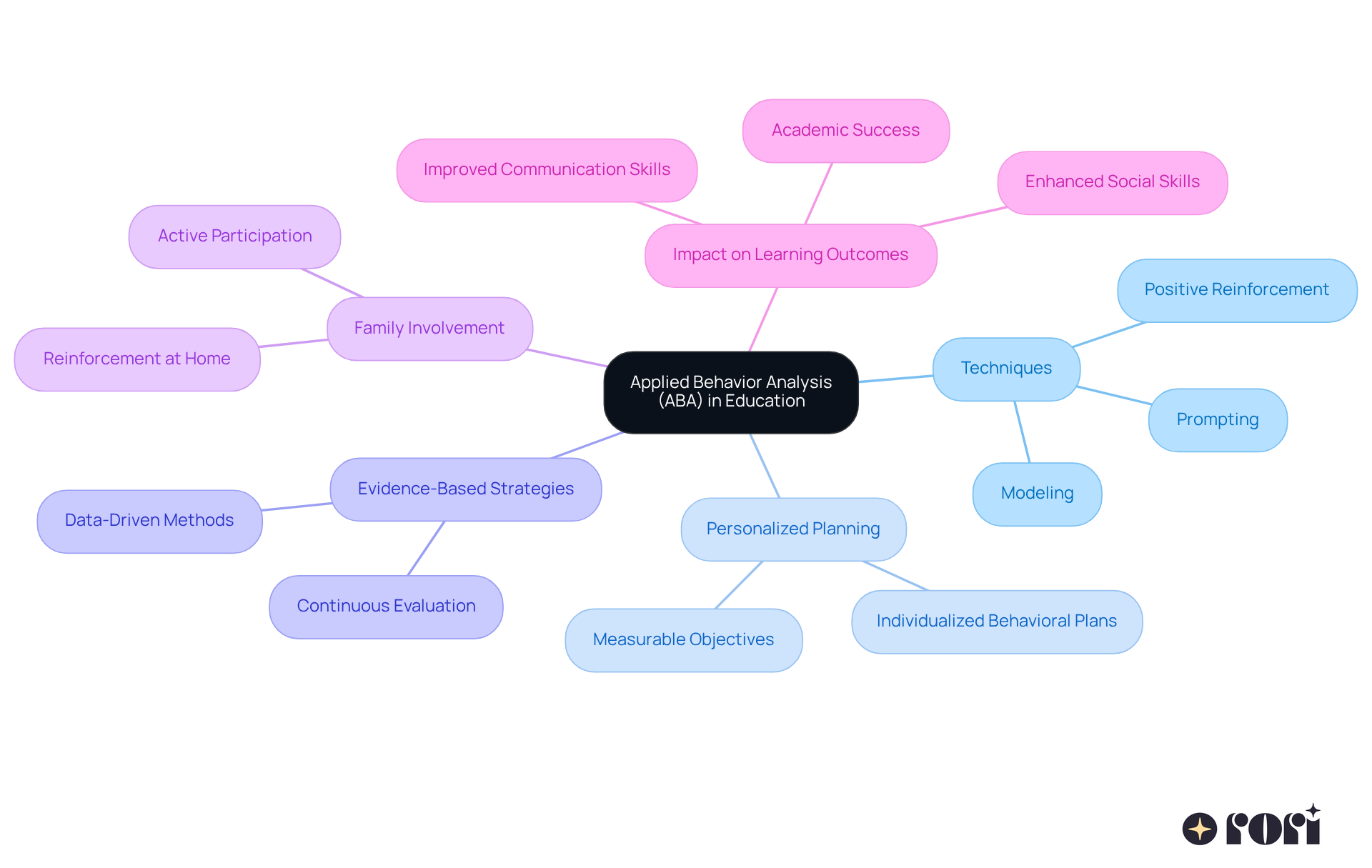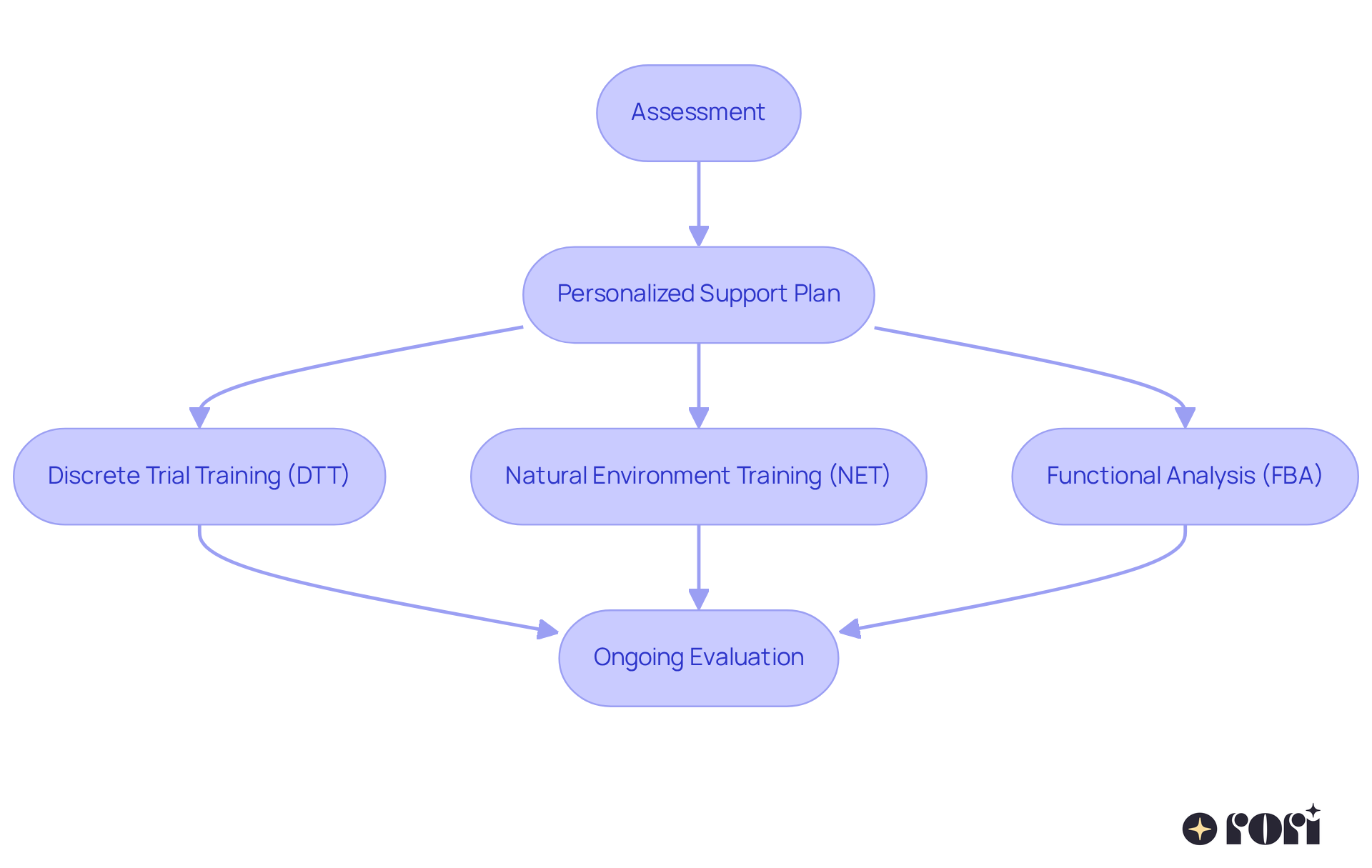Applied Behavior Analysis (ABA) in education is a fantastic strategy aimed at improving specific actions and learning outcomes, especially for children with autism and developmental disorders. Think of it as a way to help kids thrive through techniques like positive reinforcement and structured learning environments. 🌟
Imagine a classroom where personalized ABA plans, grounded in data-driven methods, can really make a difference! These plans can boost communication, enhance social skills, and lead to overall academic success. Plus, they help create a more inclusive classroom environment where every child feels valued.
Let’s explore this together! If you’re a parent navigating these challenges, know that you’re not alone. We’re here to help you every step of the way!
By embracing ABA, you’re taking a wonderful step toward supporting your child’s growth and development. It’s all about fostering connections and creating a space where learning can flourish. So, why not dive deeper into this approach? Your child’s bright future awaits!
Applied Behavior Analysis (ABA) has become a game-changer in education, especially for kids with autism and developmental disorders. By using data-driven strategies, ABA not only boosts individual learning but also creates a welcoming space where every student can shine. But as parents and educators dive into the world of ABA, some questions pop up:
Let’s explore these questions together! Understanding how ABA can foster essential skills and behaviors in the classroom is key. Imagine a classroom where every child feels included and supported—that’s the power of ABA! We’re here to help you every step of the way!
What is ABA in education involves using proven strategies to help improve specific actions and learning outcomes, particularly for children with autism and other developmental disorders. It’s rooted in behaviorism, which focuses on the clear link between actions and the environment around us. By using data-driven methods, educators can boost positive behaviors while minimizing the ones we’d rather not see. Techniques like positive reinforcement, prompting, and modeling play a big role in creating structured learning environments that help kids gain skills and improve their behavior.
At Rori Care, we believe in personalized planning. Each behavioral plan is crafted to fit the unique needs, strengths, challenges, and goals of your child. We set clear, measurable objectives for behavior change and skill enhancement, giving you a transparent way to track progress. Our behavior analysts use evidence-based strategies backed by the latest research, ensuring we apply the most effective methods for behavior change. We continuously evaluate and adjust treatment plans based on progress reports, adapting interventions to get the best outcomes. This ongoing process helps us respond effectively to your child’s needs and ensures they receive the highest quality of care.
You might find it interesting that Lovaas' 1987 research highlighted the effectiveness of ABA methods, particularly Discrete Trial Training (DTT), in achieving significant progress for individuals with autism. While DTT is a well-known approach within ABA, understanding what ABA in education encompasses is important as it includes a wider range of strategies and techniques that we utilize at Rori Care. Recent studies have shown that what is ABA in education can lead to substantial improvements in communication, social skills, and overall academic success for individuals with autism.
Educators have observed that understanding what is ABA in education not only boosts individual learning outcomes but also fosters a more inclusive classroom environment, allowing all students to flourish. The acceptance of ABA therapy in society has grown, reflecting a broader recognition of what is ABA in education and its benefits for students. Plus, family involvement is crucial for the success of ABA strategies; when families actively participate, it reinforces the skills learned at school in the home environment. What is ABA in education reveals its significant impact on learning outcomes, with evidence showing that individuals receiving ABA support make remarkable strides in interacting with peers, engaging in classroom activities, and developing essential life skills.

The story of Applied Behavior Analysis (ABA) begins in the early 20th century, shaped by influential behaviorists like John B. Watson and B.F. Skinner. Watson focused on observable actions, laying the groundwork for behaviorism, while Skinner introduced operant conditioning, which brought essential reinforcement strategies into play. Fast forward to the 1960s, when Ivar Lovaas began applying these principles specifically for children with autism. His work showed remarkable progress in behavior and learning through structured strategies. This was a game-changer, leading to the development of early intensive behavioral intervention (EIBI), which has been shown to enhance language, social skills, and cognitive abilities in autistic individuals.
Did you know that about 1 in 36 young people in the U.S. are diagnosed with autism? This highlights the urgent need for effective strategies like ABA. The U.S. Surgeon General's 1999 report even pointed to behavioral strategies as the most effective treatment for autism, solidifying ABA's role as a primary approach. Since then, ABA has evolved significantly, adapting to new research and technology. It has shifted from rigid methods to more personalized, ethical approaches that focus on positive reinforcement and the unique needs of each child.
Today, what is ABA in education is widely recognized as a vital intervention for addressing the challenges faced by individuals with autism and other learning difficulties. With the integration of modern methods like telehealth and AI-driven progress reports, therapy has become more efficient, freeing up to 50% more time for direct treatment. This not only boosts behavioral outcomes but also empowers caregivers with the knowledge and strategies they need to support their child's development. Remember, "Behavior can change. ABA proves it every day!"
Let’s explore this together! If you’re a parent navigating these waters, know that you’re not alone. We’re here to help you every step of the way!

A few key components that really make a difference when exploring what is ABA in education are assessment, strategies, and ongoing evaluation. It all starts with a thorough assessment to identify your child's strengths, needs, and specific behavioral challenges. From there, a personalized support plan is crafted, using methods like discrete trial training (DTT), natural environment training (NET), and functional analysis (FBA). Each of these approaches has its own unique role:
But it doesn’t stop there! Continuous evaluation of progress is crucial. This allows educators to tweak strategies based on real-time data collected during implementation. Research shows that kids who consistently engage in interventions based on what is ABA in education see significant improvements in adaptive behavior, cognitive skills, and social functioning. Isn’t that amazing? It really highlights how these methods can lead to successful learning outcomes.
And here’s something exciting: by integrating personalized therapy with advanced AI to monitor progress, we can free up 50% more time for youth treatment! This means caregivers can be more actively involved in supporting their child’s behavioral goals. However, we know there can be hurdles, like logistical issues and costs, that might affect therapy participation. That’s why it’s so important to have accessible support systems in place.
Let’s explore this together! If you’re feeling overwhelmed, remember that you’re not alone. We’re here to help you every step of the way!

Many educators are exploring what is ABA in education, as Applied Behavior Analysis (ABA) is making waves in various educational settings and truly impacting both special education and mainstream classrooms. In special education, teachers often turn to Discrete Trial Training (DTT) to help students with autism express their needs. This approach breaks down communication skills into bite-sized steps, rewarding successful attempts with praise or rewards. It’s all about creating a positive learning experience!
Now, let’s not forget about mainstream classrooms! ABA techniques shine here too. For instance, a token economy system lets students earn tokens for showing desired behaviors, which they can trade for fun privileges. This not only motivates kids but also helps build a positive classroom vibe. Plus, ABA encourages social skills development through structured peer interactions, helping kids navigate social situations with confidence.
With the exciting integration of AI technology, Rori Care is taking ABA therapy to the next level by automating progress report generation. This means clinicians can spend 50% more time focusing on direct youth treatment—how amazing is that? This innovation saves time for both educators and parents, allowing for more meaningful interactions. The AI technology also streamlines data collection and analysis, offering actionable insights to support children’s behavioral goals.
These practical applications of ABA highlight what is ABA in education, showcasing its versatility and effectiveness while enhancing the learning experience for all students, regardless of their individual needs. By promoting positive behaviors and improving communication skills, ABA helps create a more inclusive and supportive educational atmosphere. Let’s explore this together and see how we can support our kids in their learning journeys!

Applied Behavior Analysis (ABA) in education is truly a game-changer for enhancing learning outcomes, especially for children with autism and other developmental disorders. By using data-driven strategies rooted in behaviorism, ABA helps educators nurture positive behaviors while tackling challenges in a structured way. It’s all about tailoring interventions to meet individual needs and highlighting the crucial role families play in reinforcing skills learned at school.
Throughout this journey, we see key components of ABA, like assessment, personalized planning, and ongoing evaluation, shining as essential for success. Techniques such as Discrete Trial Training (DTT) and Natural Environment Training (NET) are effective tools for teaching skills and addressing behavioral challenges. Plus, the integration of modern technology, like AI-driven progress monitoring, shows how ABA methodologies are evolving, making interventions more efficient and accessible.
The impact of ABA goes beyond just individual improvement; it creates inclusive classroom environments where every student can thrive. As awareness and acceptance of ABA grow, it’s becoming increasingly important for educators and families to work together in applying these strategies. Embracing ABA not only enhances learning for children with unique needs but also enriches the overall educational experience, paving the way for a more supportive and understanding community.
Let’s explore this together! If you’re a parent navigating these waters, remember, you’re not alone. We’re here to help you every step of the way!
What is Applied Behavior Analysis (ABA) in education?
ABA in education involves using proven strategies to improve specific actions and learning outcomes, particularly for children with autism and other developmental disorders. It focuses on the relationship between actions and the surrounding environment.
What techniques are commonly used in ABA?
Techniques commonly used in ABA include positive reinforcement, prompting, and modeling, which help create structured learning environments that facilitate skill acquisition and behavior improvement.
How does Rori Care approach ABA?
Rori Care emphasizes personalized planning by crafting behavioral plans tailored to each child's unique needs, strengths, challenges, and goals. They set clear, measurable objectives for behavior change and skill enhancement.
How are progress and treatment plans evaluated in ABA?
Progress is tracked through ongoing evaluations, and treatment plans are adjusted based on progress reports to ensure effective responses to a child's needs and the delivery of high-quality care.
What research supports the effectiveness of ABA methods?
Lovaas' 1987 research highlighted the effectiveness of ABA methods, particularly Discrete Trial Training (DTT), in achieving significant progress for individuals with autism. Recent studies have shown that ABA can lead to improvements in communication, social skills, and academic success.
How does ABA contribute to an inclusive classroom environment?
Understanding ABA in education boosts individual learning outcomes and fosters a more inclusive classroom environment, allowing all students to flourish.
What role do families play in the success of ABA strategies?
Family involvement is crucial for the success of ABA strategies as active participation reinforces the skills learned at school in the home environment.
What are the overall impacts of ABA on learning outcomes?
ABA significantly impacts learning outcomes, with evidence showing that individuals receiving ABA support make remarkable strides in peer interactions, classroom engagement, and the development of essential life skills.